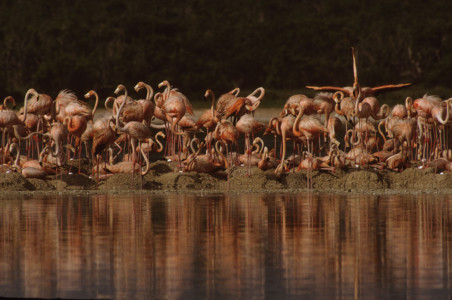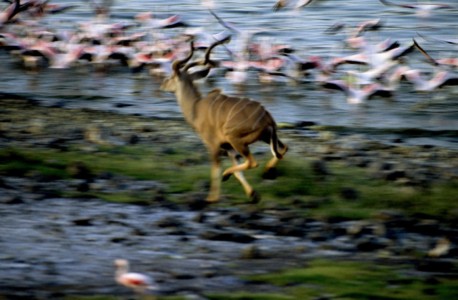Flamingo

I have photographed flamingos on three continents but now, this journey led me to three lakes in East Africa; Elmentieta, Bogoria, and in this photo, Nakuru. Here, a crimson ocean of a million courting and feeding flamingos (mainly Lesser) pulse (or you could say dance, instead of pulse) around the shoreline and shallows.

Phoenicopterus Ruber (the American or Caribbean flamingo) probably 100,000 through a range from Florida to Venezuela, west of Yucatan Peninsula, with an isolated population in the Galapagos. Then came European explorers and settlers…

As a young photographer, this close proximity to the Inagua breeding colony of Caribbean flamingos, spiked my thrill meter into the red. I had to modulate this excitement with focused camera work.

Unfortunately, I was paired with a local videographer on this wade into a flamingo colony, whose intent was on getting dangerously close. A fall into a shallow sink hole doused his equipment and plans.

Just these feathers remained of a Blue & Gold Macaw that had died while for sale in a market in La Paz, Bolivia.

I took two days off from flamingo work in India to explore: one to the Gir National Reserve and its Asiatic lions, the other to the Melghat Reserve and this calm but dangerous tiger.

Near a market in Potosi, Bolivia, these ladies are packing coca leaves, which are consumed by either chewing or in tea, without the destructive nature of cocaine.

I knew how the slightest disturbance can scatter a breeding colony of flamingos and its eggs. I chose to stay respectfully back, a choice many photographers would not have made.

The largest of the three South American flamingo species, this Andean adult drifted peacefully by feeding, as I hid behind a rock at Laguna Colorada. Bolivia at 14,000 ft.

A long, difficult drive brought me to this isolated Uru Chipian village of flamingo hunters. Bolivia. This elder is spinning wool yarn.

Sunsets and flamingos seems to be a favorite shot for me. India, over the Little Rann, near Zainabad.

The Camargue region of southern France has a well-protected flamingo population. These Bee-Eaters were nesting nearby.

Arles, France. Non-lethal bull fighting (la course Camarguaise) with matador (raseteur) plucking a ribbon from between the bull’s horns.

Kenya offers the opportunity to capture multiple species in one frame -- here, a Kudu with Great and Lesser Flamingos.

A Kudu with Great and Lesser Flamingos, fleeing from melanistic (dark colored) leopard, just off frame.
“The earth will not continue to offer its harvest, except with faithful stewardship. We cannot say we love the land and then take steps to destroy it.”
– Pope John Paul II













